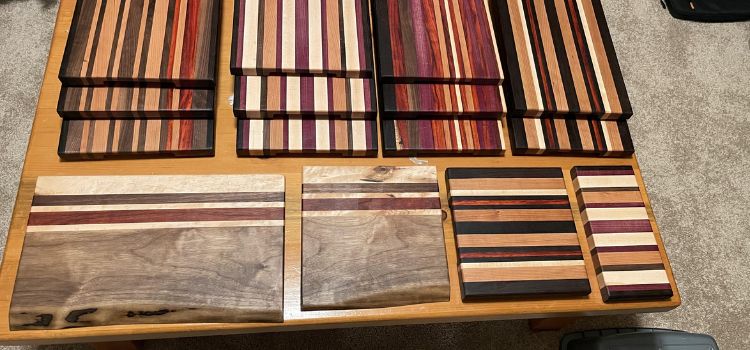As an Amazon Associate, I earn from qualifying purchases

In the world of kitchen tools, few items are as essential as the cutting board. This humble yet vital piece of equipment serves as the stage for culinary creativity, handling everything from slicing vegetables to carving roasts. Choosing the right material for a cutting board is crucial, not only for the longevity of the board itself but also for maintaining the sharpness of your knives.
Among the myriad of options available, bloodwood presents an intriguing choice. Known for its striking appearance and robustness, bloodwood is a material worth examining for any home cook or professional chef. This article explores the properties of bloodwood, compares it with other popular cutting board materials, and evaluates its suitability for kitchen use.
Properties of Bloodwood
Bloodwood, named for its deep, rich red color, is a tropical hardwood that originates primarily from South America. This wood is renowned for its exceptional hardness and durability, making it a formidable option for various applications, including furniture, flooring, and, of course, cutting boards. Bloodwood’s density contributes to its strength, allowing it to withstand heavy chopping and resist the wear and tear common in a busy kitchen environment.
The aesthetic appeal of bloodwood cannot be overstated. Its vibrant color and fine grain pattern provide a unique and luxurious look that can enhance the visual appeal of any kitchen. However, these properties also present challenges. The sheer hardness of bloodwood, while beneficial for durability, can be less forgiving on knives. Frequent use may lead to dulling, requiring more regular sharpening.
Another aspect to consider is bloodwood’s stability. Its dense nature means it is less prone to warping and cracking, particularly when properly maintained. Its low porosity helps resist moisture absorption, which is a critical factor in preventing bacterial growth—a key consideration for any cutting board material.
Comparison with Other Cutting Board Woods
When comparing bloodwood to other popular cutting board materials like maple and walnut, several factors come into play. Maple is often the go-to choice for cutting boards due to its balance of hardness and knife-friendliness. It is tough enough to endure continuous use while still being gentle on knife edges. Additionally, its light color and subtle grain make it a versatile option that complements various kitchen styles.
Walnut, on the other hand, offers a darker hue and softer touch than maple, making it a favorite for those who value aesthetics alongside functionality. While not as hard as maple, walnut provides an excellent compromise between durability and ease of maintenance.
In contrast, bloodwood offers a unique visual appeal with its rich red coloring and superior hardness, positioning it as a more exotic choice. However, this comes at the cost of potentially dulling knives more quickly than its counterparts. The decision to choose bloodwood over maple or walnut ultimately hinges on personal preference—whether one values the unparalleled beauty and durability of bloodwood over the more practical aspects of other woods.
Pros and Cons of Using Bloodwood for Cutting Boards

Advantages of Bloodwood Cutting Boards:
- Durability: Bloodwood’s robustness ensures longevity, allowing it to withstand years of use with proper care, making it a worthwhile investment.
- Aesthetic Appeal: The standout color and unique grain pattern of bloodwood can serve as a striking focal point in the kitchen, attracting those who value luxurious and distinctive designs.
Disadvantages of Bloodwood Cutting Boards:
- Knife Wear: The hardwood’s toughness, while enhancing durability, can be tough on knives, requiring more frequent sharpening to maintain their effectiveness.
- Maintenance Needs: Bloodwood boards often require specific care routines to keep them in prime condition. Regular oiling is essential to prevent drying and to preserve the wood’s natural sheen.
- Cost and Availability: Being an exotic wood, bloodwood can be more expensive and less widely available compared to common options like maple and walnut, making it a consideration for budget-conscious buyers.
Overall, when choosing a bloodwood cutting board, it’s important to weigh its visual and functional benefits against these potential drawbacks.
Conclusion
In conclusion, bloodwood presents an intriguing choice for cutting boards, offering a blend of beauty and durability that few other woods can match. Its unique characteristics make it an excellent option for those who prioritize aesthetics and are willing to invest in regular maintenance and knife care. However, for cooks who prioritize practicality and ease of maintenance over visual appeal, traditional options like maple or walnut might be more suitable.
Ultimately, the decision to use bloodwood as a cutting board material should align with your kitchen habits and personal preferences. If you are looking for a cutting board that combines robustness with a striking appearance, and you’re prepared to maintain both the board and your knives, bloodwood might be the ideal choice for you. By carefully considering your needs and the demands of your kitchen environment, you can ensure that your cutting board not only enhances your culinary efforts but also complements your kitchen’s style and functionality.
FAQ
Can bloodwood be used for cutting boards?
Yes, bloodwood can be used for cutting boards due to its exceptional hardness and vibrant appearance. Its durability makes it suitable for heavy use, though it’s important to maintain it properly and regularly sharpen knives, as the wood’s hardness may dull blades over time.
What are the disadvantages of bloodwood wood?
Bloodwood’s primary disadvantages include its tendency to dull knives quickly due to its hardness and its need for regular maintenance to preserve its rich color and prevent drying. Additionally, its exotic nature can make it more expensive and less readily available compared to other woods.
What is Bloodwood good for?
Bloodwood is excellent for projects requiring durability and striking visual appeal, such as high-end furniture, flooring, and decorative inlays. Its vibrant red hue and fine grain make it a popular choice for artistic woodworking, musical instruments, and any application where aesthetics and strength are desired.
As an Amazon Associate, I earn from qualifying purchases